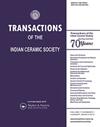莫来石基高铅玻璃熔窑的研制
IF 1.5
4区 材料科学
Q3 MATERIALS SCIENCE, CERAMICS
引用次数: 1
摘要
核反应堆辐射屏蔽窗玻璃主要用于保护操作人员免受核热室核能发电过程中产生的有害放射性射线的伤害。在这方面,高铅(>70% PbO)含RSW玻璃的生产一般采用铂罐底灌流铸造技术。然而,由于高成本铂罐的容量低(最大40 L),玻璃板的生产限制在最大尺寸400×400×100 mm3。因此,高度需要一种替代的成本效益技术来制造更高尺寸的玻璃板。为满足这一要求,可采用低成本、大体积的耐火罐倾斜铸造技术。在这方面,耐火罐必须具有足够的热、化学和机械稳定性,以在1100°-1200°C下维持含有高腐蚀性氧化铅的熔融玻璃。为此,研制了一种富含莫来石的粘土基硅酸盐铝罐材料,并对其进行了系统表征。采用滑移铸造技术制备了矩形棒材,并在1450 ~ 1550℃范围内烧制了棒材,对烧制后的材料进行了体积密度、表观孔隙率、断裂冷热模量等表征。成功地熔出了氧化铅含量超过70%的水合硅玻璃,并对水合硅玻璃的质量进行了研究。在优化的坩埚组成中,形成高含量的莫来石相,具有较高的抗热震性和耐腐蚀性,并具有理想的机械稳定性,是制造无缺陷RSW玻璃板的耐火坩埚稳定性的关键因素。这种低成本的耐火罐技术可以代替铂罐技术生产更大尺寸的RSW玻璃板。图形抽象本文章由计算机程序翻译,如有差异,请以英文原文为准。
Development of Mullite Based Refractory Pot for High Lead Containing Glass Melting
Radiation shielding window (RSW) glass for nuclear reactor is primarily required for protecting the operating personnel from harmful radioactive rays produced during nuclear energy generation in nuclear hot cells. In this respect, the production of high lead (>70% PbO) containing RSW glass is generally made using platinum pot through bottom pouring flow casting technique. However, owing to low capacity (40 L max.) of high cost platinum pot, the production of glass slab is limited to a maximum dimension of 400×400×100 mm3. Therefore, an alternate cost effective technology is highly required for making higher dimension glass slabs. To fulfill the requirement, low cost and higher volume refractory pot based tilt casting technology can be adopted. In this regard, the refractory pot is to be developed with adequate thermal, chemical and mechanical stabilities towards sustaining high corrosive lead oxide containing molten glass at 1100°-1200°C. For this purpose, a clay based alumino-silicate pot material enriched with mullite has been developed and characterized systematically. The rectangular bars have been fabricated by slip casting technique and the fabricated bars have been fired between 1450° and 1550° C. The fired materials have been characterized in terms of bulk density, apparent porosity, cold and hot modulus of rupture, etc. The RSW glass with more than 70% lead oxide content has successfully been melted in the pot. The quality of RSW glass produced using the pot has also been studied. In an optimized composition of the pot, the formation of higher content of mullite phase having high thermal shock and corrosion resistance with the desired mechanical stability is the key factor behind the stability of the refractory pot for making defect free RSW glass slabs. This cost effective refractory pot technology can substitute the platinum pot technology for producing larger dimension RSW glass slabs. GRAPHICAL ABSTRACT
求助全文
通过发布文献求助,成功后即可免费获取论文全文。
去求助
来源期刊

Transactions of the Indian Ceramic Society
工程技术-材料科学:硅酸盐
CiteScore
2.40
自引率
8.30%
发文量
12
审稿时长
2.3 months
期刊介绍:
Transactions of the Indian Ceramic Society is a quarterly Journal devoted to current scientific research, technology and industry-related news on glass and ceramics. The Journal covers subjects such as the chemical, mechanical, optical, electronic and spectroscopic properties of glass and ceramics, and characterization of materials belonging to this family.
The Editor invites original research papers, topical reviews, opinions and achievements, as well as industry profiles for publication. The contributions should be accompanied by abstracts, keywords and other details, as outlined in the Instructions for Authors section. News, views and other comments on activities of specific industries and organizations, and also analyses of industrial scenarios are also welcome.
 求助内容:
求助内容: 应助结果提醒方式:
应助结果提醒方式:


